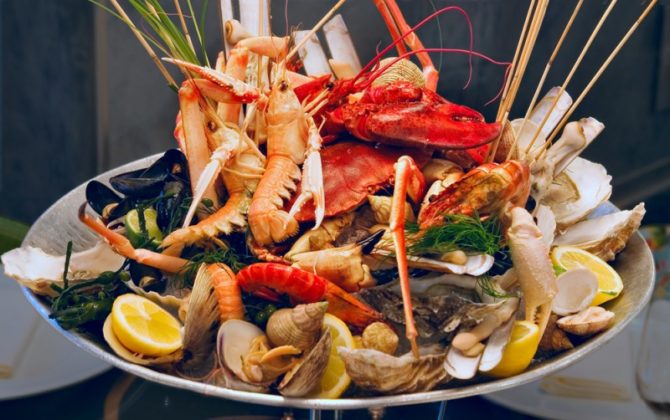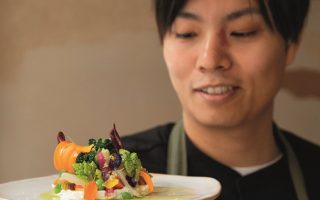A Briny and Bountiful Feast

Christmas images and aromas in France tend towards the cold and briny, starting with huge platters of shaved ice piled with shellfish and crustaceans — sea almonds, cockles, mussels, langoustines, lobster, oysters, sea snails and more, all artfully arranged. I love seeing these gift-wrapped platters emerge from the poissonnier during the holiday season, looking as if they were under their own locomotion, since it’s impossible to see who’s behind them. It isn’t just the ice and sea creatures that obscure all, but the sparkling cellophane that’s tied into a tall, crinkly peak and held in place with silver and blue ribbon.
The whole chilly nature of a French Christmas is played out in traditional holiday decorations, too, which lean to a proliferation of tiny sparkling white lights, silvery boughs, blue ribbons. Red and green are almost entirely absent, as are jolly men ho-ho-ho-ing, elves prancing, Christmas trees buried by gifts, and all the ritual parties that lead up to the big day in the US.
It took me a while to get used to this more formal approach to Noel, steeped as I am in America’s nostalgic traditions. We still hang stockings around the chimney, decorate the house, hang lights inside and out, and listen to Christmas music from dawn to dusk. I fill the house with all the old familiar aromas, from sweet spices to honey to the molasses that makes gingerbread so good. I have an annual party, to which I invite neighbors, teachers, friends and shopkeepers. I think they all find it an odd little tradition, with the mulled wine and homemade cookies, bowls of spiced nuts and mounds of sweet breads, bunches of mistletoe, fir boughs under the window, and the biggest Christmas tree I can find. But no one ever declines an invitation.
Despite my penchant for nostalgia, though, I’ve also grown fond of the French approach to Christmas. There is something gloriously elegant about it, in spite or because of its shivery nature. I love nothing more than walking down the Champs-Elysées in Paris during the Christmas season — aglitter with lights, it is an ice queen’s dream. The Eiffel Tower sparkles, ice skaters twirl in front of the Hôtel de Ville to the strains of Christmas music, the Bon Marché’s interior decorations are breathtaking, and the Printemps and Galeries Lafayette windows offer exotic fancy and color. In the last several years, dozens of Christmas markets have popped up around the city, and their little Alsatian-like chalets are cute, at least from a distance.
Like everything in France, commercial Christmas fashion changes each year. Last year, window and other public displays were filled with black-flocked Christmas trees decorated in white and silver. It was stylish, in a depressing, macabre kind of way. This year our town in Normandy has chosen turquoise and silver — in all honesty, a more cheerful option.
No matter the color or the fashion, though, Christmas in France is, like everything else here, really all about food and those traditions don’t change. Of course people make a stab at decorating their homes, and most people I know go to midnight Mass. But it’s all a prelude to the real moment of importance — one of the biggest feasts of the year.
Over the years I’ve fallen in love with the foods of the Christmas season. Always an oyster fan, here I’ve become oyster-obsessed. My Normandy Noel includes as many of them as I can reasonably consume, always washed down with a highly chilled Sauvignon Blanc or Muscadet. My favorites this year will be the lean, hauntingly briny oysters from Saint-Vaast, just off the coast of the Cotentin peninsula. Easy to open, easier to slurp, I serve them neat, with no lemon or shallot and vinegar concoction to dilute their purity.
Along with them there will be the noble scallop, in French the coquille Saint Jacques. I know I write about scallops often, but when they are as sweet, succulent, fresh and lively as they are at my market — they are less than half a day out of the water when I buy them — it’s hard to shy from the subject.
I bring them home in their shells rather than ask the fishmonger to shuck them, preferring to pry them loose myself. I slice the first few very thin to serve raw, with a little filet, or drizzle, of extra virgin olive oil and some fleur de sel. These I offer to the guests who populate the kitchen, and they are often greeted with caution — outside of the Parisian fad for sushi and sashimi, the French don’t tend to eat a lot of raw seafood. Once sampled, however, the slices disappear in a haze of favorable commentary.
The remaining scallops I leave in their cupped shells, drizzle with butter, and bake quickly so they emerge just warm in the center. Sublime.
This year I’ve introduced a new dish to my family and friends. It consists of lobster extracted from the shell of the elegant blue beasts that live all along the northern coast of France. I cut the translucent, red-tinged meat into thin escalopes, or angled slices. These I arrange in buttered dishes, drizzle with a bit of intensely flavored fish stock, sprinkle with tarragon from the garden, and bake in a hot oven for less than five minutes. The lobster emerges with an unparalleled, conversation-stopping purity of flavor and texture that is almost holy. I serve it with a gently chilled white Burgundy. At Christmas we’ll have it while we’re still in the kitchen, a-light with candles and a fire burning in the fireplace. It’s a dish that speaks of celebration, and a wonderful way to begin a festive meal.
Leaving aside the briny realm for a moment, the Christmas season also ushers in chestnuts, which abound in our local forests. We gather them — this year’s harvest has given exceptionally large and meaty ones — and roast them in the fireplace, or boil them in water scented with star anise. Apples are at their utmost during this season, too, and I take a nice, tart variety like Cox’s Orange Pippin, peel them, and slice them very thin. I brush the slices on both sides with butter and sprinkle them lightly with a mixture of ground cinnamon, cumin and fleur de sel, then bake them long and slow. They emerge sweet and salty, crisp and scrumptious.
For the main course this year, I plan to steam turbot — the most elegant of the flat fish family that includes sole, flounder, and halibut — over a thick bed of rosemary, an herb that grows year round in my garden. As a side dish, only Belgian endive will do, for it too is a denizen of the cold, chilly months. I slice it in half, lengthwise, and either sear it on the cut side so it is grilled yet still crisp, then drizzle it with almond oil; or I caramelize it with olive oil and garlic. Either way, it’s wonderful.
Our Christmas salad is often a mix of watercress and escarole that I dress with a peanut oil and grenadine vinaigrette. (The oil comes from the Leblanc family, in Burgundy.) Not only is this delicious, but the grenadine turns the shallot in the vinaigrette a nice, Christmassy red.
Homemade cookies are usually the seasonal dessert of choice, along with juicy clementines, pomegranates and sweet late-harvest grapes. For Christmas itself, though, we always make a bûche de Noël, the traditional cake in the shape of a Yule log. I don’t care for the typical light, airy kind, and instead use a recipe I got from a Basque farmer. The cake is dense and cinnamon-scented, the filling a beguiling blend of chestnut paste and chocolate, the frosting a semi-sweet ganache. I make meringue mushrooms, and we create a little forest scene on the top of our bûche.
All of this is memories-in-the-making, which is one of the best parts of Christmas, whether we are in our country of origin or our country of choice. From briny beginning to sweet finish, I wish you your own memory-filled moment, and leave you with recipes to try. Joyeux Noël et Bonne Année.
APPLE CHIPS (POMMES CHIPS)
4 medium-sized, tart apples, cored, peeled, cut into 1/8-inch thick slices
1-1/2 tbsp clarified butter
mounded 1/4 tsp ground cinnamon
mounded 1/4 tsp ground cumin
Fleur de sel
1. Preheat the oven to 275º F (135º C).
2. Brush apples slices on both sides with clarified butter, and set them on a baking sheet. In a small bowl mix cinnamon and cumin, and sprinkle the mixture evenly over apple slices. Season with fleur de sel and bake until slices are crisp, about 1 hour. Transfer to a wire rack to cool.
Makes about 100 slices
ESCALOPES DE HOMARD
2 live lobsters, weighing about 1-1/4 lbs each
3 tbsp unsalted butter
1/3 cup (75ml) mussel cooking liquid or very flavorful fish stock
20 tarragon leaves
Sea salt and freshly ground black pepper
1. Preheat the oven to 450º F ( 230º C).
2. Cut the lobster in half, lengthwise. Remove the meat, and cut it into thin slices on the diagonal.
3. Thickly butter four small, shallow, ovenproof bowls. Arrange an equal amount of lobster in each dish.
4. Drizzle an equal amount of mussel broth over each dish.
5. Stack the tarragon leaves and cut them into tiny, fine slices. Sprinkle equal amounts over the lobster. Sprinkle with fleur de sel and pepper, bake on the top shelf of the oven until the lobster is opaque through, about 6 minutes. Serve immediately.
4 to 6 servings
Susan Herrmann Loomis teaches cooking classes in Normandy and Paris.www.onruetatin.com. Find her cookbooks in the France Today Bookstore.
Originally published in the December 2009 issue of France Today; updated in December 2012
Share to: Facebook Twitter LinkedIn Email



